The Top five best national parks in Africa aims to provide you with a list of the most extraordinary and best national parks in Africa, which are lovely and fantastic for any African wildlife safari experience. This list of the top five best national parks in Africa includes the most popular and currently trending national parks to visit for your next African safari tour if you want your safari journey in Africa to be a once in a lifetime experience.
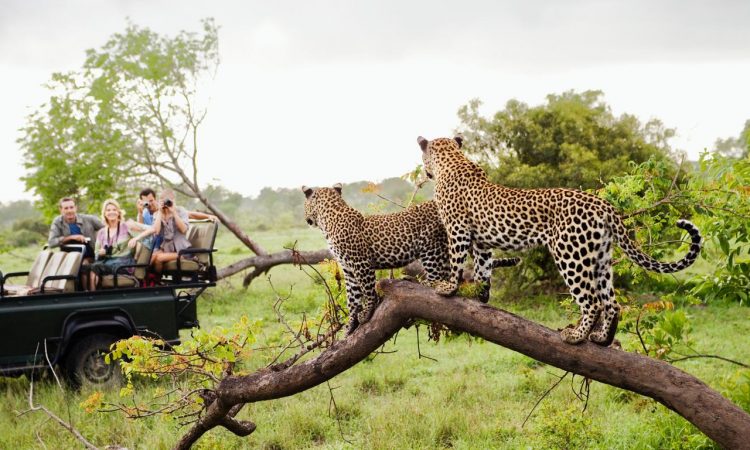
Africa, the world’s second-largest continent, is home to a vast and diverse range of landscapes, including Mount Kilimanjaro, Africa’s largest and the world’s largest free-standing mountain, and Mount Kenya, Africa’s second-largest mountain. Africa also has incredible protected areas, including national parks teeming with incredible wildlife, serene views, and mind-blowing adventures. Tanzania, Kenya, Uganda, South Africa, Zambia, Mozambique, Namibia, Rwanda, and other countries in Africa have over 100 national parks.
An African safari should be on every traveler’s bucket list and safari package because the continent has unrivaled attractions for everyone to enjoy. One of the most rewarding travel experiences is seeing some of the world’s most fascinating creatures in their natural habitat. Seeing the huge wildebeest migration in the Serengeti and Maasai Mara, as well as the ‘Big Five’ (lion, African elephant, Cape buffalo, leopard, and rhinoceros) on your African safari vacation is sometimes mandatory, sometimes optional, but always fascinating and unforgettable moment.
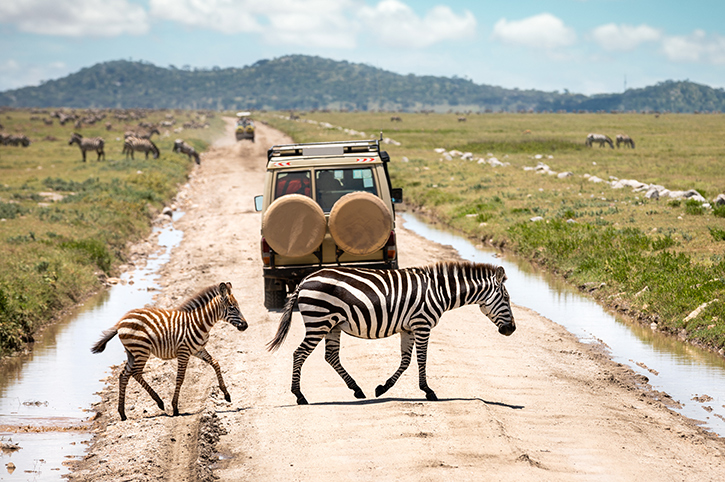
Because there are so many national parks and other safari destinations to visit and leave behind when planning your next African safari, deciding which national park and country to visit and which to leave behind has been a difficult task for everyone. It’s not like you can visit all 100 national parks in each country; it’s impossible. If that’s the case, you should have at least a list of the top 10 best national parks in Africa that should be visited, and which should be on your list.
To help you pick your perfect African safari destination or national park to visit, we’ve compiled a top 5 list of Africa’s best national parks and game reserves for your next safari excursion. Currently, the top 5 best African national parks include;
- Serengeti National Park-Tanzania
- Masai Mara National Reserve-Kenya
- Kruger National Park-South Africa
- Etosha National Park-Namibia
- Chobe National Park-Botswana
The five mentioned above are the top five best of the best national parks in Africa, and if you want your African safari experience to be unforgettable and once in a lifetime, make sure to visit at least three of them. Each national park is amazing and unique in its own right, and their beauty and uniqueness range from tourist attractions to tourist activities to outstanding world-class accommodations.
- Serengeti National Park, Tanzania
When you mention the best African national parks, everyone will be surprised that you left out the Serengeti national park. The Serengeti national park has built a reputation and popularity for being the best African number one national park, and simply put, it should be on everyone’s bucket list who is planning an African wildlife safari, as an African safari is not complete without visiting the Serengeti. Serengeti National Park is in northern Tanzania, in east Africa, and is noted for its big five, largest population of predators and great wildebeest migration.
The Serengeti National Park, a famous African safari destination, is home to some of the world’s largest mammal populations. One of the most popular sights in the pristine Serengeti Park is the annual Great Migration (also known as the Wildebeest Migration). The Serengeti National Park is one of Africa’s largest national parks, comprising some 15000 km2 of unending plains interspersed with thorn trees. It is also the best-known safari park in Africa for the great wildebeest migration. Thousands of hoofed animals move across the Serengeti Ecosystem every year from December to August, traveling between the Masai Mara in Kenya and the bigger Serengeti Park, which share unfenced boundaries.
Also, the Serengeti National Park shares a border with two other well-known and popular African national parks, the Maasai Mara National Reserve and the Ngorongoro Conservational Area, which has helped the Serengeti gain popularity and is best combined and visited in one safari itinerary and package with these national parks. Serengeti National Park is home to vast wildlife populations, with many of the species being healthy, robust specimens. The Big 5 of Africa can be found in plenty here, with lions in particular. In fact, the Serengeti Park is home to Africa’s greatest lion population. More than 500 bird species, including many raptors, can be found here also.
The Serengeti Park’s immense grasslands, thunderous calm, and boundless horizons provide an unrivaled African safari experience. Because of the vastness of this amazing wilderness area, there will be fewer tourists on game drives than in some of Africa’s other major national parks.
How to get to Serengeti National Park in Tanzania
Most of the Serengeti national park safaris start at Arusha City, the important city for Tanzania’s northern safari circuit. And the best option for getting to Serengeti national park after you have landed at Kilimanjaro international airport is by taking a domestic flight from there and landing at one of the seven airstrips present in Serengeti, or alternatively, taking road transport from Kilimanjaro international airport to Arusha city, to Ngorongoro conservation area, and then to Serengeti national park. Many East African safaris visit both the Masai Mara and the Serengeti Park, so you may simply combine the two.
Best time to visit Serengeti national park in Tanzania
The dry season is the optimum time to explore the Serengeti National Park (from late June to October). This is the best time to see animals in general, with the wildebeest migration being the ultimate highlight. Wildlife viewing is fantastic all year, but particular sites are better at certain seasons of the year. The migration’s timing varies from year to year (the best months to see it are June and July), while wildebeest calving occurs from late January to February. However, visiting the Serengeti during the dry season may be difficult for visitors who dislike crowded areas, as the Serengeti is very busy and overcrowded with visitors’ safari vehicles, and accommodations and camps in the Serengeti national park are expensive, making it difficult to visit.
Traveling in the low season is your best option if you want to avoid crowds and have a limited budget. Mid-March to mid-May (long rains), early November to mid-December (short rains), and the last two weeks of January are all times when visitor numbers are low and camp prices are substantially lower.
Tourism/safari highlights in Serengeti National Park
- Home to the great wildebeest migration
- Home to the big five
- More than 500 different bird species
- The largest population of predators in the world, especially lions,
- The world’s largest concentration of wildlife
- Home to the stunning landscape-the Serengeti endless Plain and kopjes.
Tourist activities in Serengeti National Park
- Walking safaris
- Game drives
- Hot air balloon safari.
- Horseback riding
- Cultural visit
- Birding safaris
- Camping
- Bush dinner and breakfast
- Photographic safaris
- Maasai Mara National Reserve, Kenya
The Masai Mara National Reserve is a major challenger to the Serengeti National Park, and it has long been regarded as one of Africa’s top national parks, as well as Kenya’s best national park. Maasai Mara (Masai Mara) is a safari destination in south-west Kenya that, along with the Serengeti National Park, is possibly the continent’s most popular safari destination. It is a national reserve, not a national park that belongs to the Maasai people and is managed by the local county authorities. With the Serengeti National Park in Tanzania, it constitutes one of Africa’s most diverse, magnificent, and spectacular eco-systems, with over 95 animal species and 570 bird species reported.
The Masai Mara National Reserve is the ideal African safari location, with wide savannah plains teaming with wild animals and the original ‘Out of Africa’ safari backdrop of endless savannah plains. Even seasoned safari-goers are awestruck by the Masai Mara’s wildness and beauty. The Great Migration is one of the primary attractions of Kenya’s Maasai Mara National Reserve. From July through October, millions of wildebeest, zebra, and gazelles stampede across the plains in search of greener grass in this annual animal show.
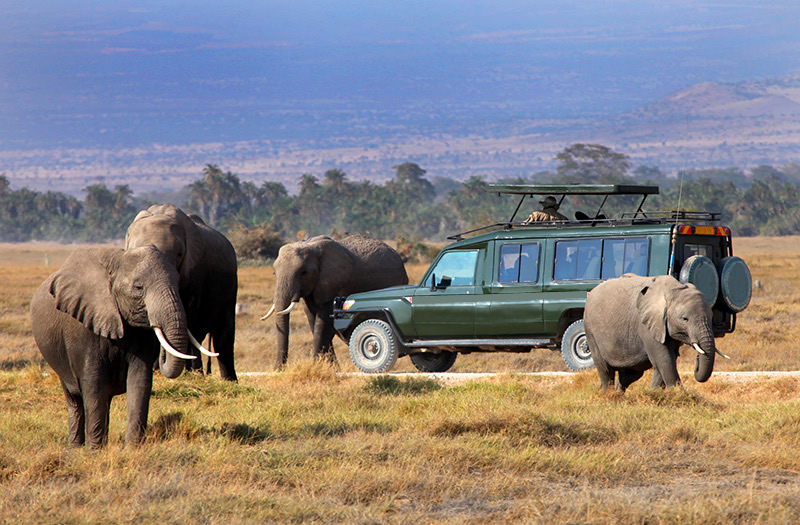
Again, like its counterpart, the Serengeti National Park, The Maasai Mara national reserve is known for its large population of predators like lions and cheetahs, as well as the 1.5 million wildebeest that migrate through the Mara and cross the crocodile-infested Mara river (from July to October).
Best time to visit the Masai Mara national reserve in Kenya
Because of its abundance of species and temperate climate, the Maasai Mara national reserve is a wonderful safari destination all year round. There are two separate rainy seasons to be aware of: the “short” rainfall of November and December; and the “long” rainfall of January and February (usually dramatic but very short-lived afternoon showers). The rains of April and May are characterized by being “long” or “heavy” (many accommodations close over this period as the black cotton soil is impassable to vehicles).
From August through October is the best time to see the Masai Mara’s wildebeest migration. August is the best month to witness the Serengeti’s dramatic river crossings into the Mara, where they’ll graze until November’s short rains force them back into the Serengeti.
The Masai Mara may get fairly crowded during high season (June to October), especially around the river crossings, so plan ahead and book up to a year in advance if you want a front-row seat for wildebeest migration viewing. It’s also a good idea to stay in one of the Maasai Mara’s private conservancies to avoid the throng at this time of year.
How to get to Maasai mara national reserve in Kenya
The Maasai Mara National Reserve is accessible via the following routes: The Maasai Mara National Reserve in Kenya, like the Serengeti National Park, is easily accessible, and the best way to get there is by taking a flight and landing into Kenya’s Jomo Kenyatta International Airport, then fly or drive to the Maasai Mara National Reserve. Nairobi city is 270 kilometers (167 miles) northwest of the Masai Mara. The road is in bad shape, and it takes around five hours to get there.
Tourism/ safari highlights in Masai Mara national reserve
- Home to great wildebeest migrations,
- Home to the big fives
- Larger numbers of predators, particularly lions.
- Birding paradise
- The largest populations of wild animals
- Home to the Maasai people
Tourist activities in Masai Mara National Reserve
- Walking safari
- Maasai Cultural Visit
- Hot air balloon safari.
- Game drives
- Horseback riding
- Bird watching safari
- Kruger National Park, South Africa
Kruger National Park, like Kenya’s Maasai Mara National Reserve and Tanzania’s Serengeti National Park, is another Africa’s best national parks, and it deserves to be on anyone’s top five list of the continent’s best national parks. Kruger National Park, considered as one of the world’s finest wildlife parks, is South Africa’s top travel destination and premier national park. Kruger Park, in north-eastern South Africa, covers over 19485 km2 of untamed bush and is home to an unequaled diversity of species. There are 145 animal species, the most of any African game park, and approximately 500 bird species among the residents.
This world-renowned South African national park is home to Africa’s Big 5, as well as a beguiling array of other wild animals, including hippos, crocodiles, and cheetahs, as well as wild dogs, giraffes, and a variety of antelope species. Kruger National Park is a well-kept and publicly accessible wildlife paradise that is widely regarded as a conservation pioneer, Top Five Best National Parks in Africa.
How to get to Kruger national park in South Africa
The best way of getting to Kruger national park is by traveling and landing to Johannesburg and then drive into the park for four hours; or take a domestic flight from Johannesburg to Kruger Mpumalanga airport and then drive into the park for an hour; or fly directly from Johannesburg to Skukuza. Private game reserves such as Sabi Sands, Thornybush, and Timbavati, all of which are excellent safari destinations, border the park.
Best time to visit Kruger National Park in South Africa
The dry season in the Kruger National Park lasts from May to October. Because the region’s vegetation is sparse and low at this time of year, it’s easier to identify and follow wildlife, and animals don’t stray far from the dry season’s last water sources. The mosquitoes are sparse, there is little to no rain, and temperatures are moderate during the day and delightfully cool at night, making it an ideal time to explore the Kruger National Park.
Keep in mind that the Kruger National Park can get quite congested during the dry season which is also tourism peak season in South Africa during June and August. A safari in one of Kruger’s private game reserves is always a good idea—these serene, exclusive-use areas are adjacent to the national park and provide unique experiences such as walking safaris and night game drives.
The rainy season begins in November and ends in April. These short-lived afternoon thundershowers turn the Kruger into a wonderful, lush green landscape, which makes for great photographic safaris. During this “green season,” however, game viewing is still entertaining. There is a lot of predator activity since so many animals give birth.
Tourist safari highlights in Kruger National Park
- Sabi Sand Game Reserve.
- Kapama Private Game Reserve.
- Timbavati Private Nature Reserve.
- Crooks Corner in the Great Limpopo Transfrontier Park.
- Elephant Hall Museum.
- Shingwedzi Rest Camp
- Klaserie Private Nature Reserve.
- Punda Maria Rest camp’s waterhole
Tourist activities in Kruger National Park
- Visit a cultural village
- Hot Air Balloon Safari
- Bush Braais
- Visit a Cultural Heritage Site
- Go on an elephant back safari.
- Game drives
- Bird watching
- Etosha National Park, Namibia
Etosha National Park is Namibia’s best and one of Africa’s top national parks, and it deserves to be on everyone’s African safari bucket list and itinerary. This one-of-a-kind national park in northern Namibia spans 22270 square kilometers and is focused on the stark Etosha Pan, with its swirling mirages and vast horizons. Given the open and desert topography, Etosha’s spectacular backdrop is excellent for observing wildlife at watering holes.
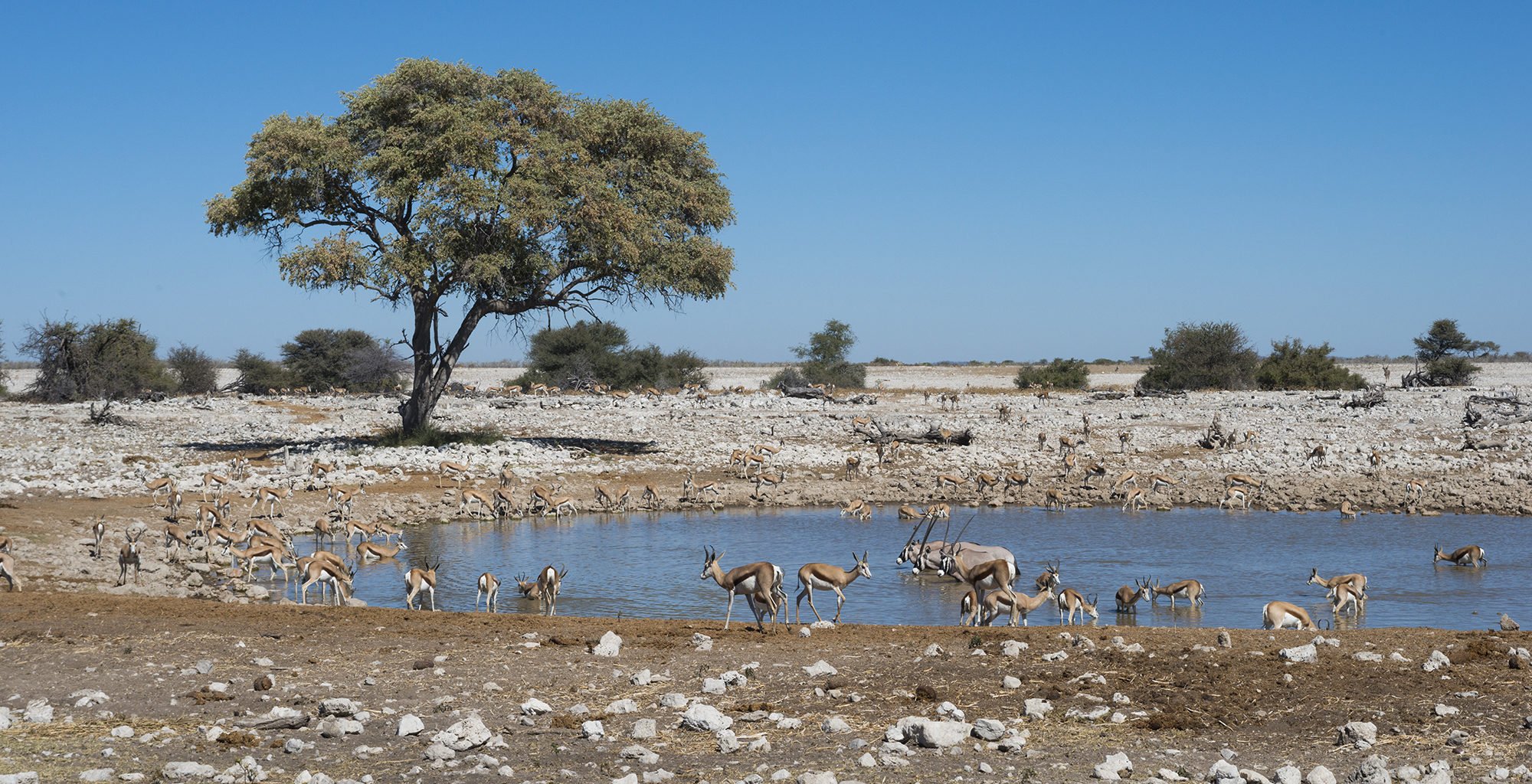
Etosha National Park is home to a variety of uncommon and exotic wild creatures, as well as Africa’s Big 5, including the continent’s tallest elephants. This cracked-clay soil changes into fields of blue-green algae, thick forests, and lush meadows after heavy rains, drawing a variety of wildlife and birds, including tens of thousands of flamingos and water birds. Rhinos, giraffes, elephants, lions, a variety of antelopes, and even cheetahs and leopards are common animal sightings. Winter (April to October) is the best time to visit Etosha Park for game viewing because the vegetation is thin and animals cluster at the watering holes.
How to go to Namibia’s Etosha National Park.
Etosha is 435 kilometers (270 miles) north of Windhoek. It is simple to visit on your own (self-drive) or on a tour. On paved roads, the journey takes roughly six hours. The roads in the park’s eastern half are suitable for 2WD vehicles. There are no regular flights, but there are three airstrips for charter flights within the park. Outside of the park, the majority of the upscale resorts have their own private airstrips.
The majority of visitors arrive in Namibia via Hosea Kutako International Airport, 40 kilometers (25 miles) east of Windhoek, and begin their journey by 4×4 vehicle from there. Fly-in trips are also popular, with chartered planes transporting visitors from one theme park to the next.
Best time to visit Etosha national park in Namibia
The best time to visit Etosha national park is during the dry season, which is the winter months in Namibia. This is the time of year when numerous animals congregate around waterholes and the grass is low, providing for better viewing.
The dry season in Etosha national park (May–October)
Many European countries have their summer vacations during this dry season. Back in Africa, the park’s wildlife viewing is at its peak, making this the greatest time to visit. Because water sources are scarce, there will be a large number of animals at the water holes. During this period, the pan is frequently bone dry, and the photographic scene creates interesting images. If you want to visit at this time, you’ll need to make a reservation ahead of time because camps are frequently fully occupied when latecomers arrive, Top Five Best National Parks in Africa.
The rainy season in Etosha national park (November–April)
During the summer, the average daytime temperature ranges from 25 °C to 35 °C, with some days exceeding 40 °C. During this season, Etosha national park transforms from a dry, dusty-white terrain to a lush green oasis. In the summer, the birdlife is abundant, with many birds from the Northern Hemisphere travelling south to Etosha. The pan itself collects water and transforms into a lake, drawing flamingos and other wetland species. Because this area receives more rainfall than Okaukeujo, many of the larger species (such as elephants) will migrate north to the Namutoni camp.
Tourist Safari highlights in Etosha National Park
- Join the Etosha “Night Life” at Okaukeujo Water Hole.
- Relax at Halali.
- Discover the native Hai||Om culture.
- Join the Dust Devils in their dance.
- Consider the vastness of the Etosha Pan.
- Forest of fairy tale
- Water holes such as Tsumcor, Okerfontein, Adamax, and Aroe
- Chobe National Park, Botswana
Chobe National Park in northern Botswana has one of the largest densities of wildlife in Africa. The Chobe region is home to Africa’s greatest continuous elephant population. Chobe Park’s 12000 km2 encompasses a wide range of ecosystems, from parched plains and dry channels to fertile grasslands, dense woodlands, and wet swamps. Its diversified ecosystems support a large density and broad range of wild animals and birds, the most notable of which are the massive elephant herds, which number in the thousands.
Chobe National Park is well-known for its game-viewing boat tours along the Chobe River, which attract a wide variety of animals and birds. The Savuti Marsh, located in Chobe’s southwest corner, is home to some of Africa’s highest year-round concentrations of animals, including predators and elephant bulls. Chobe National Park’s wildlife safaris are greatest from April to October, when herds of zebra, antelopes, buffalo, giraffe, and wildebeest congregate at water sources.
Although not a national park, the untamed Okavango Delta, also in northern Botswana, is a top safari destination in Africa. This magnificent inland delta offers a one-of-a-kind safari experience and is frequently combined in one safari bucket list with Chobe National Park.
How to get to Botswana’s Chobe National Park.
Chobe National Park is one of Africa’s most accessible top national parks, located just outside of Kasane in northern Botswana and less than two hours from Victoria Falls in Zimbabwe.
Best time to visit Chobe National Park in Botswana
Chobe can be visited at any time of year. The park’s wildlife migrates with the seasons. The best time to visit the riverfront is from May through October, when the weather is dry. The months of August through October are the best for wildlife viewing, but they are also the hottest.
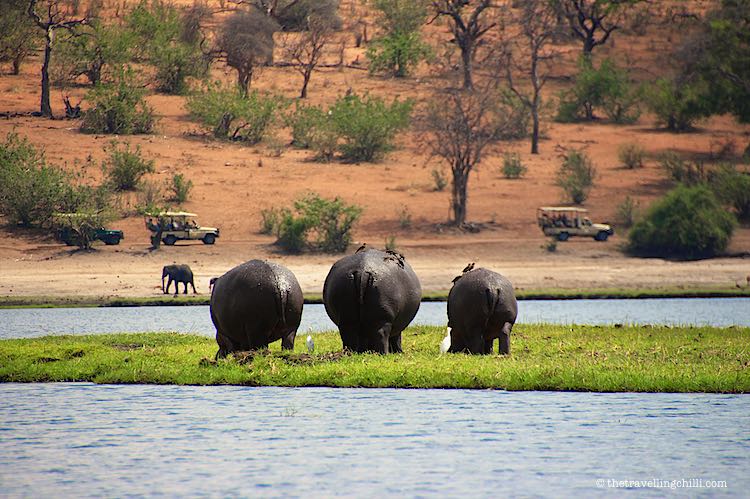
Tourism and safari highlights in Chobe National Park
- During the dry season, Africa’s largest concentration of elephants can be found.
- During the dry months, there is a spectacular gathering of animals, with large herds of buffalo, sable, and other herbivores, Top Five Best National Parks in Africa.
- There is a large predator population.
- The greatest time to go birding is during the summer months, when a large number of migrating species congregate.
- Game viewing from a boat provides a unique viewpoint on Africa’s wildlife.
- You have the option of seeing Victoria Falls on a day trip or staying in Victoria Falls and exploring the area.
- A variety of lodging alternatives are available.
Tourist activities in Chobe National Park
- Game Drives
- Boat Cruises
- Photographic Safaris
- Fishing
- Guided Bush Walks
Conclusion, out of over 100 total national parks on the African continent, the five mentioned above are our top five picks for the best national parks in Africa. These national parks are regarded as the best of over 100, and visiting them is an once-in-a-lifetime experience. We recommend that you include them in your next African safari package and bucket list. Other top African national parks include Tanzania’s Ngorongoro Conservation Area, Zambia’s South Luangwa National Park, Zimbabwe’s Hwange National Park, Uganda’s Queen Elizabeth National Park, Malawi’s Liwonde National Park, Namibia’s Namib-Naukluft National Park, Rwanda’s Volcanoes National Park, and the Republic of Congo’s Odzala-Kokoua National Park.


